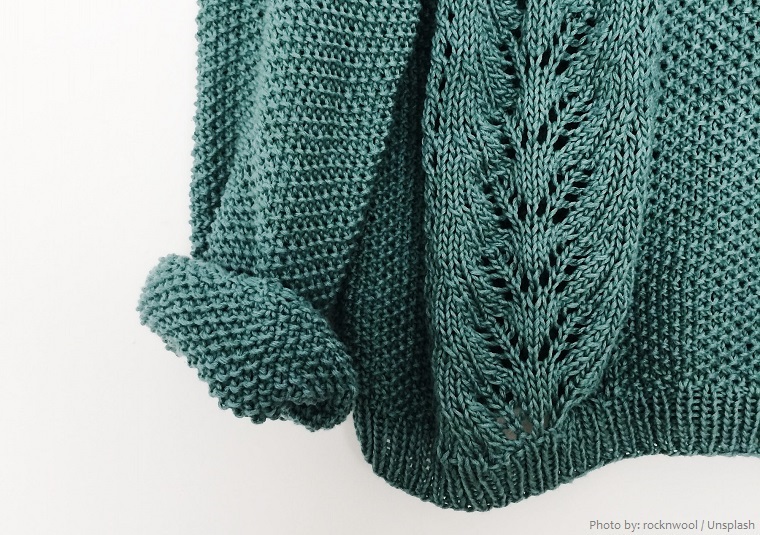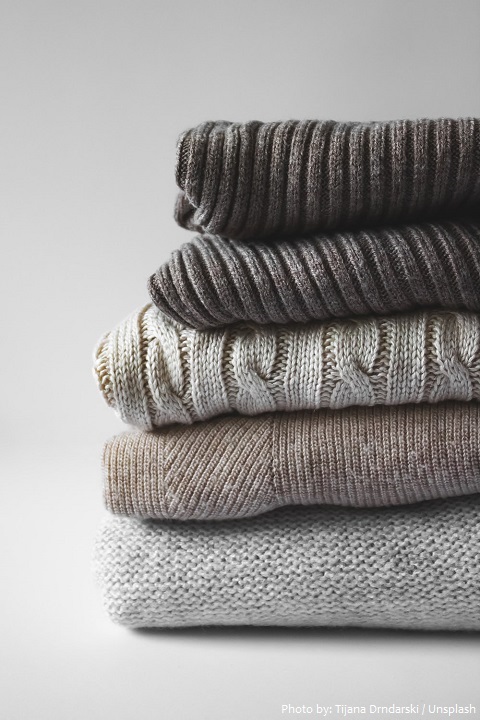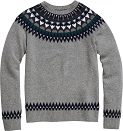
A sweater or pullover also called a jumper in British and Australian English is an outer garment, usually knitted or crocheted, that is worn on the upper part of the body, either pulled over the head or buttoned down the front or back.
When sleeveless, the garment is often called a slipover or sweater vest.
Sweaters were traditionally made from wool but can now be made of cotton, synthetic fibers, or any combination of these. There are also seasonal sweaters, which around Christmas are called “ugly sweaters”.

The sweater is a piece of garment that covers the torso and arms. There are various options of different styles and cuts of sweaters – some sweater models cover the neck of the wearer, some are designed with buttons like a waistcoat, some are made with zip neck or designed with zip from top to bottom, and some models are made with a polo neck or v-neck.
In addition to different models, sweaters are made from different materials in order to be worn in different seasons. They can be made from wool, cashmere, vicuna, cotton, silk, or a blend of these materials. Furthermore, sweaters can be woven thick or thin in terms of the weather conditions and regions where they are worn.

Although hand knitting of wool had been practiced for about 2,000 years, it was not until the 15th century that the first knitted shirts or tunics were produced on the English Channel islands of Guernsey and Jersey – hence the English name jersey. The knitted garments were made by the wives of fishermen and sailors from natural wool, which, by retaining its oil, protected against the cold even when damp.
With the development of trade, Guernseys arrived to British Isles and the coastal regions of the North Sea. People who were living there adopted these sweaters and called them Gansey, instead of Guernsey. Later on, the popularity of Guernseys expanded across European countries and they became high in demand especially in the labor class due to its durability and thickness.
In the following decades, the sweater was worn by cyclists, players of polo and cricket, and golfers. Indeed, it became a piece of garment worn during leisure activities and this led sweaters to be integrated into country side wardrobes.
In the mid 19th century, the gansey was adopted by the Royal British Navy, and they are still part of the uniform for various members of the British military. At the same time, knitted sweaters from Fair Isle in the Scottish Shetlands were first being traded off the island. Elsewhere in the British Isles, the Aran sweater, which hails from the Aran Islands off the coast of Ireland, was adapted from the gansey sweaters brought by fisherman brought in to help improve the local fishing industry. Local women then altered the sweater and began knitting an all-over pattern.

Until the first few decades of the 20th century, the sweater remained a functional garment for certain professions and communities, but that all changed as fashion became a driving force behind clothing choices.
The cardigan was named after James Brudenell, 7th Earl of Cardigan, a British Army major general who led the Charge of the Light Brigade at the Battle of Balaclava during the Crimean War. The term originally referred only to a knitted sleeveless vest, but expanded to other types of garment over time. Coco Chanel is credited with popularizing cardigans for women because “she hated how tight-necked men’s sweaters messed up her hair when she pulled them over her head.” The garment is mostly associated with the college culture of the Roaring Twenties and early 1930s, being also popular throughout the 1950s, the 1970s and the 1990s. Cardigans have also regained popularity during the 2010s.
According to British dictionaries, “sweater” is used in British English in the same sense as in American English but “jumper” is commonly used instead (though some say that “sweater” is used for heavier ones worn for warmth). Oxford University states that in British usage sweaters are always pulled over the head and jumpers are not necessarily, whereas most or all other British dictionaries disagree and say that sweaters are not necessarily pullovers or even say that jumpers are always pullovers, i.e. never open in front.
The OED gives “sweater” as appearing in 1882 and gives its definition as “A woolen vest or jersey worn in rowing or other athletic exercises, originally… to reduce one’s weight – now commonly put on also before or after exercise to prevent taking cold. Hence a similar garment for general informal wear – a jumper or pullover”

